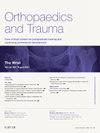腕部去神经支配:手术决策和技术考虑
Q4 Medicine
引用次数: 0
摘要
继发于创伤或退行性变的手腕疼痛影响到越来越多的个体,导致功能下降、社会心理影响和相关的社会经济成本。腕部去神经支配是治疗慢性腕部疼痛的一种保持运动的手术选择。它依赖于对腕部解剖学的理解,选择性地断开正中神经、桡骨神经和尺神经或没有尺神经的远端桡尺和腕关节分支。已经描述了几种不同的手术方法,这里概述了我们首选方法的原因。手术指征包括:舟状骨创伤、Kienbock病、炎症性关节炎、尺腕基台和职业相关振动手综合征。适当的患者选择依赖于详细的病史和评估。术前局部麻醉可用于临床模拟和预测手术结果。部分和全部去神经都能改善客观测量的握力和疼痛量表,这反映在术后高的工作恢复率上。缓解的持续时间是可变的,手术不影响疾病进展,因此应告知患者,可能需要进一步的功能限制手术。术后并发症包括复发、瘢痕压痛和少见的神经瘤。部分神经切除术可以与其他保持运动的手术干预一起进行,它可以延迟或避免功能降低手术的需要。因此,它是腕部外科医生装备中的关键工具。本文章由计算机程序翻译,如有差异,请以英文原文为准。
Wrist denervation: surgical decision-making and technical considerations
Wrist pain, secondary to trauma or degeneration, impacts an increasing number of individuals, resulting in reduced function, psychosocial impact and an associated socioeconomic cost. Wrist denervation is a motion-preserving surgical option in the management of chronic wrist pain. It relies on an understanding of wrist anatomy to selectively disconnect distal radio-ulnar and carpal articular branches of the median, radial and, or without, ulnar nerves. Several surgical variations have been described and the reasons for our preferred method is outlined here. Surgical indications include following scaphoid trauma, Kienbock's disease, inflammatory arthritis, ulnocarpal abutment and occupation-associated vibration hand syndrome. Appropriate patient selection relies on a detailed history and evaluation. Preoperative local anaesthetic may be administered in clinic to simulate and predict surgical outcomes. Both partial and total denervation results in improvement of objectively measured grip strength and pain scales, and this is reflected by the high return to work rate postoperatively. The duration of relief is variable and the surgery does not influence disease progression, so patients should be counselled that further, function limiting surgeries may be required. Postoperative complications include recurrence, scar tenderness and rarely neuroma. Partial neurectomy can be performed alongside other motion-preserving surgical interventions and it may delay or obviate the need for function-reducing surgeries. As such it is a key tool in the wrist surgeon's armamentarium.
求助全文
通过发布文献求助,成功后即可免费获取论文全文。
去求助
来源期刊

Orthopaedics and Trauma
Medicine-Orthopedics and Sports Medicine
CiteScore
1.00
自引率
0.00%
发文量
57
期刊介绍:
Orthopaedics and Trauma presents a unique collection of International review articles summarizing the current state of knowledge and research in orthopaedics. Each issue focuses on a specific topic, discussed in depth in a mini-symposium; other articles cover the areas of basic science, medicine, children/adults, trauma, imaging and historical review. There is also an annotation, self-assessment questions and a second opinion section. In this way the entire postgraduate syllabus will be covered in a 4-year cycle.
 求助内容:
求助内容: 应助结果提醒方式:
应助结果提醒方式:


